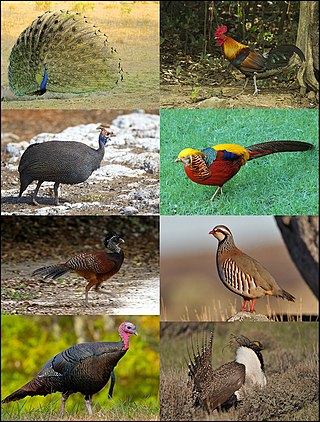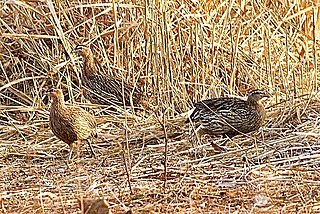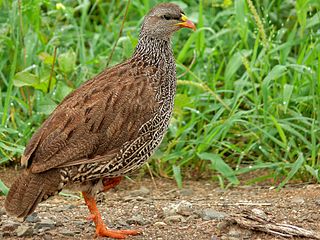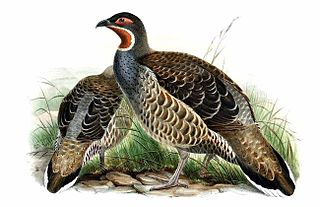
Galliformes is an order of heavy-bodied ground-feeding birds that includes turkeys, chickens, quail, and other landfowl. Gallinaceous birds, as they are called, are important in their ecosystems as seed dispersers and predators, and are often reared by humans for their meat and eggs, or hunted as game birds.

Junglefowl are the only four living species of bird from the genus Gallus in the bird order Galliformes, and occur in parts of South and Southeast Asia. One of the species in this genus, the red junglefowl, is of historical importance as the direct ancestor of the domestic chicken, although the grey junglefowl, Sri Lankan junglefowl and green junglefowl are likely to have also been involved. The Sri Lankan junglefowl is the national bird of Sri Lanka. They diverged from their common ancestor about 4–6 million years ago. Although originating in Asia, remains of junglefowl bones have also been found in regions of Chile, which date back to 1321–1407 CE, providing evidence of possible Polynesian migration through the Pacific Ocean.

Galloperdix is a genus of three species of bird in the pheasant family, Phasianidae. These terrestrial birds are restricted to the Indian Subcontinent, with the red spurfowl and painted spurfowl in forest and scrub in India, and the Sri Lanka spurfowl in forests of Sri Lanka. They share the common name "spurfowl" with the members of the genus Pternistis which are widely distributed in Africa.

Francolins are birds in the tribe Gallini that traditionally have been placed in the genus Francolinus, but now commonly are divided into multiple genera.

The double-spurred spurfowl is a gamebird in the pheasant family Phasianidae of the order Galliformes, gallinaceous birds. Like most spurfowls, it is restricted to Africa. It is a resident breeder in tropical west Africa, but there is a small and declining isolated population in Morocco.

The red-necked spurfowl or red-necked francolin, is a gamebird in the pheasant family Phasianidae that is a resident species in southern Africa.

Pavo is a genus of two species in the pheasant family. The two species, along with the Congo peafowl, are known as peafowl.

The Cape spurfowl or Cape francolin is a gamebird in the pheasant family Phasianidae. It is endemic to southern Africa, where it is the largest francolin. It occurs in the Western Cape province of South Africa, and locally northwards to southern Namibia. It has adapted to alien vegetation and a variety of human-altered habitats, but scrubby roosting and nesting space is a prerequisite. The species is not threatened.

Clapperton's spurfowl is a species of bird in the family Phasianidae. It is found in Cameroon, Central African Republic, Chad, Eritrea, Ethiopia, Mali, Mauritania, Niger, Nigeria, Sudan, and Uganda.

Harwood's spurfowl, also known as Harwood's Francolin, is a species of bird in the family Phasianidae. It is a grey-brown bird with red bill and tail, and red bare skin around the eyes. Both sexes have similar coloring, although the female is paler in color with a more extensive buff belly.

Hildebrandt's spurfowl is a species of bird in the family Phasianidae. It is found in Burundi, Democratic Republic of the Congo, Kenya, Malawi, Mozambique, Rwanda, Tanzania, and Zambia. The species is named for Johann Maria Hildebrandt, who collected the first specimens in Kenya. The sexes differ markedly in their plumage and females are smaller than males.

Heuglin's spurfowl is a species of bird in the family Phasianidae. It is found in Central African Republic, Democratic Republic of the Congo, South Sudan, and Uganda. The German explorer Theodor von Heuglin first described the species.

The Natal spurfowl or Natal francolin is a species of bird in the family Phasianidae. It is found in Botswana, Eswatini, Mozambique, South Africa, Zambia, and Zimbabwe.

The scaly spurfowl is a species of bird in the family Phasianidae. It is found in Angola, Burundi, Cameroon, Central African Republic, Republic of the Congo, Democratic Republic of the Congo, Equatorial Guinea, Ethiopia, Gabon, Kenya, Malawi, Nigeria, Rwanda, São Tomé and Príncipe, Sudan, Tanzania, and Uganda.

Tetraophasis is a genus of Galliformes in the family Phasianidae, which includes chickens, pheasants, partridges, grouse, turkeys, quail, and peafowl. It contains the following species:

The Phasianinae are a subfamily of the pheasant family (Phasianidae) of landfowl, the order Galliformes. The subfamily includes true pheasants, tragopans, grouse, turkey and similar birds. Although this subfamily was considered monophyletic and separated from the partridges, francolins, and Old World quails (Perdicinae) till the early 1990s, molecular phylogenies have shown that this placement is paraphyletic. For example, some partridges (genus Perdix) are more closely affiliated to pheasants, whereas Old World quails and partridges from the genus Alectoris are closer to junglefowls. There are two clades in the Phasianinae: the erectile clade and the non-erectile clades. Both clades are believed to have diverged during the early Oligocene, about 30 million years ago.

Perdicinae is a polyphyletic former subfamily of birds in the pheasant family, Phasianidae, regrouping the partridges, Old World quails, and francolins. Although this subfamily was considered monophyletic and separated from the pheasants, tragopans, junglefowls, and peafowls (Phasianinae) till the early 1990s, molecular phylogenies have shown that these two subfamilies actually constitute only one lineage. For example, some partridges are more closely affiliated to pheasants, whereas Old World quails and partridges from the Alectoris genus are closer to junglefowls. Due to this, the subfamily Perdicinae is no longer recognized by the International Ornithological Congress, with the species being split among 3 subfamilies.

Pternistis is a genus of galliform birds formerly classified in the spurfowl group of the partridge subfamily of the pheasant family. They are described as "partridge-francolins" in literature establishing their phylogenetic placement outside the monophyletic assemblage of true spurfowls. All species are endemic to Sub-Saharan Africa, excepted the double-spurred spurfowl. They are commonly known as spurfowls or francolins, but are closely related to jungle bush quail, Alectoris rock partridges, and Coturnix quail. The species are strictly monogamous, remaining mated indefinitely. They procure most of their food by digging. Spurfowls subsist almost entirely on roots, beans of leguminous shrubs and trees, tubers, and seeds, and feasting opportunistically on termites, ants, locusts, flowers, and fruit. Important predators are jackals, caracals, servals, and birds of prey, as well as herons and marabou storks.


















